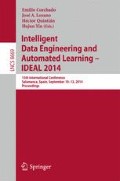Abstract
In this paper, we describe a new application operated with eye-blink for physically handicapped children who cannot speak to communicate with others. Process of detecting blinks is performed in the following steps. 1) To detect an eye area 2) To distinguish opening and closing of eyes 3) To add the method using saturation to detect blink 4) To decide by a conscious blink 5) To improve the accuracy of detection of a blink We reduce the error to detect a blink and pursue the high precision of the eye chasing program. The degree of disablement is varied in children. So we develop the system to be able to be customizes depends on the situation of users. And also, we develop the method into a communication application that has the accurate and high-precision blink determination system to detect letters and put them into sound.
Access this chapter
Tax calculation will be finalised at checkout
Purchases are for personal use only
Preview
Unable to display preview. Download preview PDF.
References
Let’s Chat, http://panasonic.co.jp/phc/products/home/communicationaids.html
Viola, P., Jones, M.J.: Rapid Object Detection using a Boosted Cascade of Simple Features. In: IEEE CVPR (2001)
Lienhart, R., Maydt, J.: An Extended Set of Haar-like Features for Rapid Object Detection. In: IEEE ICIP 2002, vol. 1, pp. 900–903 (September 2002)
Tsukada, A.: Automatic Detection of Eye Blinks using Spiral Labeling. In: Symposium on Sensing via Image Information (SSI 2003), vol. 9, pp. 501–506 (June 2003)
Joblore, G.H., Greenberg, D.: Color Spaces for Computer Graphics. Computer Graphics 12, 20–27
Author information
Authors and Affiliations
Editor information
Editors and Affiliations
Rights and permissions
Copyright information
© 2014 Springer International Publishing Switzerland
About this paper
Cite this paper
Torii, I., Ohtani, K., Takami, S., Ishii, N. (2014). Development of Eye-Blink Controlled Application for Physically Handicapped Children. In: Corchado, E., Lozano, J.A., Quintián, H., Yin, H. (eds) Intelligent Data Engineering and Automated Learning – IDEAL 2014. IDEAL 2014. Lecture Notes in Computer Science, vol 8669. Springer, Cham. https://doi.org/10.1007/978-3-319-10840-7_2
Download citation
DOI: https://doi.org/10.1007/978-3-319-10840-7_2
Publisher Name: Springer, Cham
Print ISBN: 978-3-319-10839-1
Online ISBN: 978-3-319-10840-7
eBook Packages: Computer ScienceComputer Science (R0)

